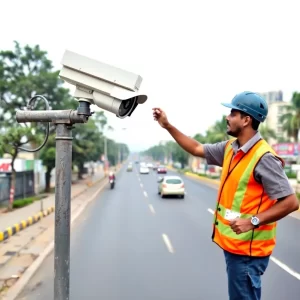Mumbai, often hailed as the financial capital of India, is a city that pulsates with life, ambition, and an unyielding spirit. However, beneath this vibrant facade lies a troubling reality: the city’s roads have become a battleground of lawlessness, with a blatant disregard for traffic rules and regulations. Despite the installation of an extensive network of CCTV cameras at an exorbitant cost, the effectiveness of this initiative is being called into question as the chaos on the streets continues unabated.
The Illusion of Surveillance
The government’s investment in CCTV technology was intended to enhance road safety and enforce traffic laws. However, the reality is starkly different. Instances of reckless driving, signal jumping, and dangerous maneuvers have become commonplace. Bikers weave through oncoming traffic, while autorickshaws and private cars disregard signals with impunity. Even the city’s iconic BEST buses are not immune to this lawlessness, often seen flouting traffic rules without a second thought.
This rampant disregard for the law raises a critical question: if the cameras are watching, then why are the roads still so dangerous? The answer lies in the pervasive belief that the law can be circumvented with the right amount of money. Citizens have come to understand that penalties, such as traffic challans, can easily be managed or dismissed altogether—creating a culture where the law is seen as a mere suggestion rather than a mandate.
A Culture of Impunity
The pervasive corruption within the system has fostered an environment where traffic violations are not only common but also expected. Many drivers operate under the assumption that as long as they are willing to pay a bribe, they can escape the consequences of their actions. This culture of impunity extends beyond the city limits, where the situation often worsens. In neighboring areas, auto-rickshaws frequently operate without functioning meters, and even when they do, many drivers refuse to use them, leaving passengers vulnerable to overcharging and exploitation.
The Maharashtra government’s failure to address these basic issues of road safety and regulation enforcement is disheartening. Citizens find themselves grappling with the consequences of a system that prioritizes profit over safety, leaving the roads perilous and unpredictable.
A Call for Accountability
As Mumbai continues to grapple with these challenges, it is imperative for the government to reassess its approach to traffic management and law enforcement. The installation of CCTV cameras, while a step in the right direction, cannot serve as a panacea for a deeper systemic issue. It is crucial to implement stringent measures that hold violators accountable and restore faith in the rule of law.
This includes regular audits of the CCTV systems to ensure they are operational and effective, increased police presence on the roads, and a zero-tolerance policy towards corruption. Additionally, public awareness campaigns can educate citizens about the importance of following traffic laws and the consequences of reckless behavior.
Conclusion
Mumbai’s CCTV Initiative: A Costly Endeavor in a Lawless Landscape
. The citizens of Mumbai deserve better than a city where safety is compromised and the law is negotiable. It is time for the Maharashtra government to prioritize the well-being of its citizens, ensuring that the roads are not just monitored but are safe for all. Only then can Mumbai reclaim its status as a great city, where the rule of law prevails and the spirit of its people can thrive without fear
